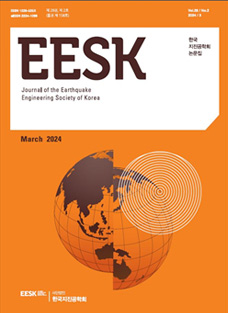1 Introduction
Currently, buildings are designed for seismic loading with a more or less accurate measure of damage. Damage is better related to story drifts than member forces exceeding capacity. For attaining performance objectives, the allowable drift must not be exceeded. Thus, it is convenient to use displacement-based design rather than force-based design for performance-based seismic design as discussed by Priestley [1]. Many methods exist for displacement-based design, and their simplicity, completeness, versatility, and performance have been assessed by Sullivan [2]. Based on the assessment, DDBD is found to be a better alternative than other methods. DDBD is applicable for regular, low and medium-rise structures in which the first-mode effect is significantly dominant but results in less accurate designs for irregular and high-rise structures where higher-mode effects become significant. Many researchers have investigated the extension of DDBD to consider these effects.
Numerous studies to incorporate higher-mode effects in DDBD have been undertaken. Pettinga and Priestley [3] revised the design displacement equations of Reinforced Concrete (RC) frame buildings, which were originally developed by Loeding et al. [4], to include highermode drift amplification in DDBD framework. The study by Pettinga and Priestley [3] was performed on RC tube frames ranging from two to 20 stories. These frames do not represent building frames with longer spans where gravity load action dominates and are vertically regular. The P-Δ effect is also not considered. In his Ph.D. thesis based on the NTHA of four-, eight-, 12- and 20-story vertically regular frames, Suarez [5] showed that the design displacement equations are significantly affected by P-Δ effect, building height, number of stories and ground motion intensity. Thus, he suggested design displacement equa- tions that include building height, number of stories and ground motion intensity as variables. It was also observed that the maximum drift does not occur at the first story as suggested in DDBD’s framework. Amaris [6], for wall-type structures, combined DDBD-obtained inelastic first mode and elastic higher-mode force effects by the Square Root of Sum Squares (SRSS) method. This modal combination is called Modified Modal Superposition (MMS). MMS gives a satisfactory result for a short-period wall while for a long-period wall, it is slightly conservative since higher-modes tend to exceed the constant acceleration plateau of the response spectrum. MMS provides inconsistent and generally excessively conservative predictions of story shear forces for RC frames. The cause as explained by Priestley [1] is that higher-mode periods in RC frames are significantly increased as the frames yield. Thus, the higher-mode effects are lower compared to walls as their response slides down the constant velocity slope of the response spectrum. For dual wall-frame structures, the MMS can be used, but the structure’s stiffness is modeled by Sullivan et al. [7] as follows. For members that have become inelastic at their ends, zero post-yield stiffness of plastic hinges is used while elastic (cracked) stiffness is used for members that remain elastic. Using a modal analysis of such a model, higher mode periods are obtained and, consequently, elastic higher-mode effects. This method is found to be over-conservative for wall moments and under-conservative for wall shears. Cheng [8] formulated a nonlinear bending stiffness matrix for flexural members with a plastic hinge at one end and/or both ends. This method needs the ratio of post-yield stiffness to initial stiffness of the plastic hinge, which is determined after the design is completed unless assumed first. A method called effective mode shape for bridge design by Kowalsky [9] determines the mode shapes and pier displacements based on secant stiffnesses for yielded piers, elastic stiffness for the superstructure and piers that remain elastic. An elastic-perfectly plastic model is used for the force-displacement response of the piers. The technique uses iteration to find the secant stiffnesses of the piers until the desired joint displacement is obtained. When the approach is verified by NTHA, abutment force and displacement outputs show significant errors.
Design using a method called effective modal superposition, proposed by Alvarez [10], gives reasonable results for medium- and shortspan RC bridges. It is based on a structural model that uses secant (effective) stiffness at the maximum displacement for members in the inelastic range. The secant stiffnesses for the piers and abutments are obtained iteratively until the target displacement profile for the bridge is attained. To achieve this, lateral forces found according to DDBD procedure are applied on such a model to estimate displacements of the piers and abutments. For the model with stabilized secant stiffness, elastic higher-mode force effects are determined using a response spectrum analysis which are then combined with DDBD-obtained force effects by the appropriate modal superposition technique. The method cannot be directly applied to building frames since beams are expected to yield rather than the columns (except at the first story columns). This makes estimating the secant stiffness of the inelastic members difficult. In addition, the iterative nature of the method makes it more computationally demanding for buildings than for bridges. To alleviate the above-mentioned problems, in this paper, a seismic design approach is proposed. The proposed procedure of the case studies when checked by NTHA results in the desired performance. It reduces the extensive use of NTHA for the design verification of planar RC buildings with stiffness and/or mass irregularities along the building height.
2 The Proposed Seismic Design Procedure for Planar RC Frame Buildings
2.1 Introduction
A seismic design procedure is proposed for planar buildings to alleviate shortcomings of Direct Displacement-Based Design (DDBD). The main tasks undertaken in this paper are
-
1) Devising an equation of design displacement profile for planar buildings that achieve the allowable inter-story drift. The equation is applicable for planar buildings with mass and stiffness irregularity along the height.
-
2) Deriving an equation, accurate enough for design purpose, that calculates members’ moment of inertia reduction factors. These factors when assigned to the structural members, results in the lateral stiffness of the buildings that does not exceed the design story displacements as design lateral loads and seismic weights are applied. The building with lateral stiffness modified as such represents the equivalent linear system of the inelastic system with combined elastic and hysteretic damping.
Before applying the proposed procedure, member dimensions are assumed and seismic weights are determined. A given performance objective is chosen which the building must fulfill under specified seismic hazard levels anticipated at the building site. With the above data obtained, the steps to be followed are given below.
Step 1) By the weak beam-strong column failure mechanism, beams and first-story columns are expected to form plastic hinges at their ends; thus, the moments of inertia reduction factors αb for beams and αc for first-story columns are used to consider the yielding.(1)
Where Ir,b and Ir,c are the reduced beams’ and first-story columns’ moments of inertia in the direction perpendicular to seismic load application, respectively. Ig,b and Ig,c are the gross beams’ and firststory columns’ moments of inertia for the direction perpendicular to the load application, respectively. Any αb and αc values less than one can be assumed as the choice of the factors does not affect the end values. αb values are lower than αc since two plastic hinges are expected at the beam ends, whereas a single plastic hinge at the base is desired for the first-story columns. αb and αc can be applied easily as section property modifier factors in the structural analysis software.
Step 2) Perform a modal analysis and find first-mode shape values and the first-mode period of the structural model modified as in Step 1. Using an elastic damping ratio (i.e., 5 percent) as a start for the mean displacement response spectrum of the ground motions, obtain the nodal displacements, ui, using Eq. 2.
Where ϕi is the first-mode shape at the ith story, Γ1 is the first-mode modal participation factor and D1 is the first-mode spectral displacement for the mean displacement spectrum of the selected ground motions.
Step 3) Scale ui to fit the design displacement, Δi, based on the allowable inter-story drift ratio, θ as
Where uj and uj-1 are the first-mode nodal displacements at story j and j-1 respectively. hj is the jth story height. j = 1,2,3…n. n stands for the number of stories.
Step 4) Find the effective mass, meff, effective height, Heff, design displacement at effective height, Δd, average yield rotation, θy,avg, yield displacement at effective height, Δy, ductility, μ, equivalent viscous damping ratio, ξeq, effective period, Teff, base shear for the first mode, Vb, and lateral force at story ith, Fi, using equations of DDBD (Priestley et al. [11]), which are also provided in the appendix. The displacement response spectra for the equivalent viscous damping ratios can be plotted using spectra generating software. In this study, SeismoSpect 2016 software is used.
Step 5) Apply Fi and the seismic weight of the building to find the output displacement, δi, using a linear structural analysis. To include P-Δ effects, the steps to be followed need to be modified slightly as follows: The additional lateral force due to P-Δ at story i, designated as Qi and given in Eq. (4), is added to Fi when determining the output displacement, δi. Qi is given by MacGregor [12].
where Pi is the sum of story seismic weights at the ith level and above i. hi is the ith story height.
Step 6) Set a new moment of the inertia reduction factor for beams α’b and for columns α’c as in Eq. (5), where i = 1,2,3...n. n is the number of stories.
Eq. (5) is determined based on the following observation. Scaling of αb and αc by a given constant does not significantly change the firstmode shapes, ϕi, and first-mode modal participation factor, Γ1. Though the first-mode period changes and results in a different spectral displacement, D1, D1 cancels out from Eq. (3). Hence, the design displacements, Δi, and the story lateral forces, Fi, remain unaltered. If so,(6)
and for multi-story frames,(7)
where i = 1, 2,3...n. n is the number of stories. [Kinitial] is the lateral stiffness matrix of the frames with Ig,b and Ig,c modified by αb and αc, respectively. [Kfinal] will then be approximated as the final lateral stiffness matrix with Ig,b and Ig,c modified by α’b and α’c, respectively, where α’b and α’c are as given by Eq.(5).
Step 7) Using the building frame with members modified with the new reduction factors α’b and α’c, apply Fi of Step 5 to find the force effects by the linear structural analysis.
Step 8) Combine the force effects from Step 7 with the elastic highermode force effects by the modal combination rule-in this case, the SRSS method. The elastic higher-mode force effects are obtained from the elastic response spectrum analysis of the structural model described in Step 7. Total modes contributing at least 90 percent of the total mass suffice to be combined. Design force effects will be the sum of seismic weight force effects and the modal-combined force effects.
Step 9) Beams and columns are designed by the capacity design principle. When designing plastic hinges, expected material strength is used, and the strength reduction factor is set as unity (Priestley et al. [11]). Beam ends and the base of the first-story column are designed as plastic hinges, whereas at other column locations, design moments are given as follows:(8)
where φs is the strength reduction factor and φo is an overstrength factor. MA and MD are the applied moment and design moment, respectively. Section dimensions from Step 1 are used for rebar calculation.
2.2 Numerical Examples
Twelve moment-resisting RC frames with a maximum of twenty stories, in four categories (Fig. 1(a)-(d)), are used for the verification of the proposed design method by NTHA. The 20-story limit is chosen, as it will be uneconomical to design a building with only RC frame as its lateral resisting system above that limit (Ali and Moon [13]). Each category contains three frames of 12, 16 and 20 stories as shown in Fig. 1 below. For each category, the 12- and 16-story structures’ column dimensions are 800 mm × 800 mm for all stories, while the beams are 700 mm × 300 mm and 800 mm × 300 mm, respectively, for all stories. The 20-story columns and beams for all categories have dimensions of 850 mm × 850 mm and 850 mm × 300 mm, respectively, for all stories. The concrete material used for all frames has a characteristic cylinder strength, f’c, of 30 MPa, while the characteristic yield and ultimate strength for the rebar is 413.69 MPa and 620.53 MPa, respectively. Expected strength of the concrete and rebar steel is obtained by multiplying the corresponding characteristic strengths by 1.3 and 1.1, respectively. Seismic loads on the frames, excluding their own weight, acting on the 5-, 7- and 8-meter span beams are 25 kN/m, 35 kN/m and 40 kN/m, respectively.
In this study, the structures must fulfill a basic safety objective as stated in FEMA-356 [14]. To achieve this performance objective, Life Safety (LS) and Collapse Prevention (CP) performance levels shall not be exceeded for Design Basis Earthquake (DBE) and Maximum Credible Earthquake (MCE) hazard levels, respectively. Story drift ratio is used as the acceptance criteria as this parameter is directly related to non-structural and structural damage. Thus, as per FEMA- 356 [14], the inter-story drift ratio shall not be higher than 2 percent for Life Safety (LS) and 4 percent for Collapse Prevention (CP) (FEMA 356, Table C1-3). Structural members’ plastic rotations shall not exceed allowable FEMA 356 plastic rotations (Tables 6-8 and 6-9 of FEMA 356).
The site chosen for the study is located in the U.S. State of California, specifically situated at 37° North, -122° West. The soil type for the site is class C (very dense soil and soft rock). Using the PEER NGA-West 2 ground motion database, an ASCE code acceleration response spectrum can be generated, thus obtaining a response spectrum for DBE. The response spectrum for MCE is 1.5 times the ordinates of the response spectrum for DBE. Eleven ground motions (Tables 1 and 2) are selected and scaled to match the 5-percent damping MCE and DBE response spectra over the period range of interest (Fig. 2(a)-(b)). Search parameters to be input into the PEER ground motion database are obtained from hazard de-aggregation for the site using the USGS Beta Unified Hazard tool.
After obtaining the 5-percent damping ratio acceleration response spectrum for DBE and MCE, the proposed design procedure is applied. To determine the secant stiffness of the frames, moment of inertia reduction factors αb for beams and αc for first-story columns need to be obtained. Kowalsky [9] and Kappos et al. [15] recommend the secant stiffness of RC bridge piers be reduced to 10 percent of the uncracked section stiffness for piers that respond inelastically. It is assumed that plastic hinges for bridges are expected to form at the bases only. Priestley [1] used 0.14 times the gross section stiffness for degraded beams to achieve the expected rotational ductility of 7 for RC frames. In this study, the values of the reduction factors are chosen arbitrarily. The aim is to find the secant stiffnesses of the frames that result in the desired displacement profile. Therefore, αc is assigned 0.3 and αb as 0.1. Using Step 2, find the first-mode joint displacements using DBE and MCE displacement response spectra. Step 3 is performed for both LS- and CP-allowable inter-story drift ratios, i.e., 2 percent and 4 percent, respectively. When the initial design displacement at effective height, Δd,initial, exceeds the peak value of the mean displacement response spectrum for the equivalent damping ratio, iteration is required to get the reduced final design displacement, Δd,final at the lower equi- valent damping ratio as per Priestley et al.[11]. Hence, the story design displacements are reduced by the ratio Δd,final/Δd,initial. The DDBD base shear, Vb, for the two performance levels is compared, and the maximum is taken as the governing design criteria. Then, the subsequent steps are followed to obtain the required design beam moments. Column end moments, MD, are amplified in this study by the ratio φo/φs = 1.2 (assuming φs = 0.9 and φo = 1.1) to achieve a beam-sway mechanism.
Table 3 below shows the new moment of inertia reduction factors for the planar frames, the governing performance level for design , the number of modes included to incorporate 90 percent of the seismic mass and modal participation ratios.
2.3 Verification of the Proposed Method by NTHA
Before verification of the proposed method, the number and size of longitudinal rebars of the members are calculated using the Section Designer module of SAP2000 V.18. When the first-story column rebars are different from the columns’ base plastic hinge rebars, the plastic hinges at the column base are incorporated as part of the first-story columns’ bottom ends with a length equal to the plastic hinge length, as calculated by Priestley et al. [11].
The structures are then analyzed using SAP2000 V.18 with FEMA 356 hinges assigned to the members’ ends. The NTHA load case includes the application of the seismic weight at the initial stage followed by analysis for the ground motions.
For the RC members, the Takeda hysteresis model is chosen for the hinges’ cyclic strength and stiffness degradation modeling. To account for the inherent elastic damping in the structures, the Rayleigh damping model is used. The mass and stiffness matrix coefficients are found with a 3-percent damping ratio assigned at periods 1.5 times the fundamental period and a period for the first mode which captures 90 percent of the seismic mass (FEMA P-1051 [16]). A P-Δ option is included in the analyses. The average acceleration method of the Newmark-beta numerical integration technique is used for the NTHA.
3 Results and Discussion
From the mean NTHA drift outputs, it is observed that the allowable inter-story drift ratios, i.e.: 2 percent for 12- and 16-story frames and 4 percent for the 20-story frames, are not exceeded (Figs. 3-6). Design drifts, obtained using the design story displacements, are not exceeded when compared to the mean NTHA drift outputs for all 12- and 16-story planar frames (Figs. 3-6). For the 20-story planar frames, the design drifts are not exceeded for Category one and two, while for Category three and four, they are exceeded for some stories (Figs. 3-6). There is better correspondence between mean NTHA and design drifts for the 20-story frames than the 12- or 16-story frames. The mean NTHA drifts for the 12- and 16-story frames are low compared to the design drifts, rendering the method conservative for the LS performance level. This may be because secant stiffness of the frames obtained based on the 2-percent drift ratio gives elastic higher-mode periods that produce significant elastic force effects. Thus, design for these force effects makes the frames have higher strength than required. NTHA drift outputs tend to be higher at bottom half stories for vertically regular cases (Category one and two). For the vertically irregular cases, higher drifts are obtained at top half stories. This scenario agrees with works by Suarez [4], Malekpour and Dashti [17] and Karimzada [18], which state that maximum drifts can be observed in higher stories other than the first story as assumed by DDBD’s method, even when frames are designed by the DDBD. Figs. 4, 5
For the 12- and 16-story frames in all categories, beam and column hinges’ status outputs of the NTHA show that the desired performance level is not exceeded. For the four 20-story planar frames, some ground motions exceeded the governing performance level. This is acceptable as long as the allowable parameters are higher than the mean NTHA outputs.
For all the 12- and 16-story frames, the mean NTHA displacements are overestimated by this procedure, and the NTHA displacements for all ground motions are contained within the design displacements. This is partly due to the significant elastic higher-mode force effects (as compared to the 20-story frames) that resulted in the design of the frames with excess strength (Figs. 7-10). Figs. 8, 9
For Categories one and two 20-story frames, mean NTHA displacements tend to vary less significantly in bottom half than top half stories (Figs. 7-10). Categories three and four 20-story frames show good correspondence between the mean NTHA and design displacements (Figs. 7-10).
Some of the other factors causing discrepancies between the design and mean NTHA outputs are as follows:
-
Members with similar force effects from the analysis are categorized in one unit, and for design, the maximum of the similar values is used; thus, some members in the unit will have a higher capacity than required.
-
In this study, beams are assigned equal moment capacities along a given bay (but not necessarily equal negative and positive moments) and designed using the maximum moments of all beam moments along the bay. This results in a conservative design.
-
Code specified strength reduction factors increase section capacity more than required.
-
The parametric and empirical nature of DDBD’s equations induces errors.
4 Conclusions
A seismic design procedure is proposed as an extension of the DDBD method to include higher-mode effects for planar RC frame buildings by determining secant (effective) stiffness of the frames that achieve the design displacements. Design displacements which limit the story drift below the allowable has been devised based on the response spectrum analysis of the frames, thereby taking into account the effect of stiffness and mass irregularity along height on the design displacements. P-Δ effect is considered using simple to apply and nonparametric equation hence applicable for general cases.
The procedure results in designs that do not exceed the desired performance level without redesigning the members. Designs of 12- and 16-story frame Categories tend to be conservative, resulting in low mean NTHA displacement and drifts compared to the 20-story Categories. This may be due to the elastic higher-mode periods resulting in significant force effects and high lateral stiffness of the frames imposed by the governing allowable drift ratio of the 12- and 16-story frames.
NTHA displacements and drifts of the frames designed by the proposed method show that those parameters are affected by the variaitons of bay width, variable mass and stiffness along the height, number of stories, and setback.
The design method can be applied to frames other than moment resisting RC frames (i.e.: steel, precast, prestressed, etc.) by using the equations of yield drift ratio, equivalent viscous damping ratio and strength and overstrength factors for the intended frame types.
Validation by NTHA of the case studies showed that the proposed design procedure yields desired outputs. It is a step forward toward reducing the use of NTHA for the design verification of planar RC building structures.






















